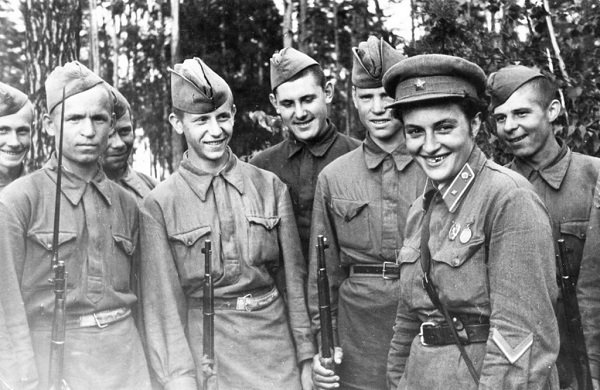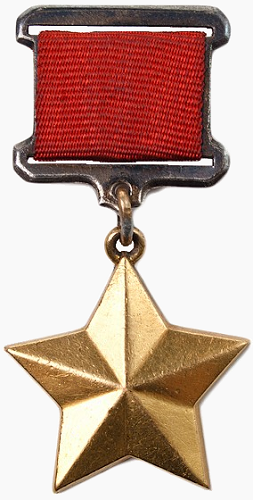History - Lyudmila Pavlichenko, Russian Sniper Known as 'Lady Death'
Sometime last year, while looking through I can’t remember what, I came across a Russian sniper who’d served in the Second World War whom I’d not heard of before and decided to find out more.
Lyudmila Belova was born on the 12th of July 1916 to Mikhail Belov and Elena Belova in present-day Ukraine. When she was 14, her father, a locksmith, moved his family to Kiev.
Thanks to the rapid industrial development of the Soviet Union and the worldwide depression of the 1930s, young women were encouraged to further their studies in college, to work and take part in military training.
Already a keen athlete, Lyudmila joined a shooting club and proved herself as an amateur sharpshooter, earning her Voroshilov Sharpshooter badge, an honorary title and badge for marksmanship.
Voroshilov Sharpshooter Badge (Wikipedia)
In 1932, Lyudmila married Alexei Pavlichenko, and their son, Rostislav, was born that same year.
Unfortunately, the marriage didn’t last, and after it was dissolved, she returned to live with her parents.
To support herself and her young son, she got a job as a grinder at the Kiev Arsenal factory and attended night school, enrolling at Kiev University in 1937, studying history.
While at university, she was also enrolled in a military-style sniping school for 6 months to further develop her skills.
On the 22nd of June 1941, Germany launched Operation Barbarossa, its invasion of the Soviet Union.
Aged 24 at the time and in her 4th year at university, Lyudmila made her way to the Odessa recruiting office, one of the first round of volunteers.
The recruitment officer attempted to persuade her to sign up as a nurse, but she refused. On producing her shooting certificates, she was finally enrolled into the Red Army’s 25th Rifle Division as a sniper, one of 2000 women snipers of the Red Army during the war of which only 500 would survive.
Most of the major commands in the Red Army had special sniper units, and Lyudmila was assigned to the 25th Chapayev Rifle Division, named after its first commander during the First World War, Vasily Chapayev.
Along with the other recruits, she received what could only be considered a condensed version of basic military training and sniper tactics as time was of the essence.
Despite being the largest army in the world, the Red Army was ill-equipped to deal with the rapidly advancing Germans.
Issued the standard sniper’s rifle, the Mosin-Nagant bolt-action rifle, Lyudmila joined a large number of recruits and replacements to be transported by train to the front in Moldavia, where fighting had already commenced against Romanian and German forces.
Mosin-Nagant Infantry Rifle Model 1891 (Wikipedia)
Her unit’s mission was to protect the southern approach to Odessa, not only the Soviet Union’s most important port of trade, but also the site of a naval base.
The siege of Odessa began on the 8th of August 1941.
It didn’t take the new recruits long to wonder if they had what it took to be snipers, realising there was a vast difference between shooting a target and shooting to kill another human being.
It was the sudden death of a young soldier she’d befriended that hardened Lyudmila; positioned not far from her, he’d taken a shot to the head.
By the following day, she’d claimed the first of her kills.
Along with her fellow snipers, she was given free rein to move about the battlefield, usually leaving camp in the early hours and returning at night.
28 days after the start of the siege of Odessa, as August drew to a close, Lyudmila reached 100 confirmed kills, and was promoted to Senior Sergeant.
There was no let up by the enemy as they continued to attack Odessa with artillery and fighting in the streets, turning the city into a fiery battleground.
On the 9th of October, Lyudmila suffered a head injury when hit by a splinter from a shell.
Moved to a medical unit for treatment, she was released just before Odessa fell on the 15th of October 1941.
As the Black Sea Fleet evacuated thousands of soldiers and civilians, specialist groups put Stalin’s scorched-earth policy into effect, destroying much of the city.
Lyudmila and her unit landed at Sevastopol, considered an effectively defensible location, ringed as it is by mountains, which protect the city and harbour.
With barely any time to catch their breath, the reinforcements from Odessa found themselves back in battle as, by the 28th of October, Sevastopol was the only city in the Crimea that hadn’t fallen to the Germans.
All through November and into December, the Germans made several attempts to secure the city, but were hampered by heavy rains and snow.
The Russians refused to surrender the city despite the relentless artillery and mortar attacks that battered Sevastopol, destroying most if not all the buildings.
All through the siege of Sevastopol, which lasted until the 4th of July 1942, Russian snipers continued to exact a deadly toll, taking out many German soldiers.
One of those snipers was Lyudmila, who’d been promoted to junior lieutenant.
Because of her devastating ability with a sniper rifle, she’d been given the moniker ‘Lady Death’.
Amidst the fighting, she also spent time training other snipers.
In the field, she often worked together with Sergeant-Major Leonid Kitsenko, who had been wounded alongside her at Odessa. Their relationship blossomed and the assumption is that they married.
Sadly, probably sometime in early Spring 1942, Kitsenko was wounded by a shell and died in Lyudmila’s arms.
By May 1942, Lyudmila had been promoted to the rank of Lieutenant, and was cited by the Southern Army Council for killing 257 Axis soldiers.
At the beginning of June 1942, Sevastopol and its defenders were bombarded by heavy artillery, and bombs dropped by the Luftwaffe.
Destroyed harbour of Sevastopol during siege of the city by Axis forces, July 1942 (Wikipedia)
Barely any Russian soldier escaped injury and Lyudmila was no exception.
After being hit in the face with shrapnel from a mortal shell, she was transferred to a field hospital. From there, she was evacuated to Moscow via submarine by order of the Soviet High Command, who recognised her as a valuable asset they couldn’t afford to lose.
That marked the end of her time in combat.
Her final tally stood at 309 official kills.
Lyudmila spent about a month in hospital, recovering from her injury, after which she trained other snipers.
Her other role was as a spokeswoman for the Red Army, mobilising support for a second front in Europe to help Russia against the Germans.
In late 1942, Lyudmila toured America, Canada and Britain.
While in America, she was welcomed at the White House by the then president, Franklin D. Roosevelt, making her the first Soviet citizen to be received by an American president.
Eleanor Roosevelt, the First Lady, invited Lyudmila to tour the country and speak about her combat experiences.
Lyudmila with Eleanor Roosevelt and Justice Robert Jackson, 1942 (smithsonianmag)
At first, newspaper reports spoke of her in a condescending manner; to her credit, she answered the questions as courteously as possible.
In an interview with Time Magazine on the 28th of September 1942, she was more blunt:
“I am amazed at the kind of questions put to me by the women press correspondents in Washington. Don’t they know there is a war? They asked me silly questions such as do I use powder and rouge and nail polish and do I curl my hair. One reporter even criticized the length of the skirt of my uniform, saying that in America women wear shorter skirts and besides my uniform makes me look fat.”
In Chicago, she stood before large crowds, speaking plainly in her efforts to garner agreement to support a second front:
“Gentlemen, I am 25 years old and I have killed 309 fascist invaders by now. Don’t you think, gentlemen, that you have been hiding behind my back for too long?”
Instead of causing offence, her words were greeted with cheers of support.
When she returned to the Soviet Union, Lyudmila continued to train snipers until the end of the war.
In 1943, she was awarded the Gold Star of the Hero of the Soviet Union, the highest distinction given to a Soviet citizen, along with the Order of Lenin, the highest civilian decoration.
When the war ended, Lyudmila was discharged with the rank of major.
She returned to Kiev University to finish her degree, after which she worked as a historian and research assistant at the Soviet Navy headquarters from 1945 to 1953. She was also active in the Soviet Committee of the Veterans of War.
In 1957, the former first lady, Eleanor Roosevelt, visited Moscow.
Despite the restrictions caused by the Cold War, Roosevelt’s persistence paid off and she successfully met with Lyudmila, 15 years after their first meeting in America.
The loss of her second husband, Leonid Kitsenko, had taken a heavy toll, and Lyudmila suffered from depression, alcoholism, and what would now be recognised as PTSD.
Lyudmila Pavlichenko died on the 27th of October 1974, due to a stroke; she was 58.
She is buried in Novodevichy Cemetery in Moscow, and her son, Rostislav, who died in 2007, is buried next to her.
Having researched her story, its obvious that, if the war hadn’t started, Lyudmila’s life would have been so different.
She’d have graduated and worked as a history teacher, possibly a researcher, and lived out her life in quiet anonymity.
Instead, she was placed in a position, maybe way out of her comfort zone, where she discovered what she was capable of in defence of her country.
On a personal note, it is an odd feeling to read she died a day before my 11th birthday, and she was the age I am now.
If you’re interested in more photos of Lyudmila, this site – ww2gravestone.com – has an extensive collection.







